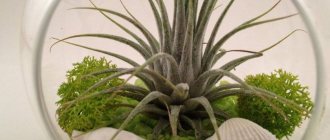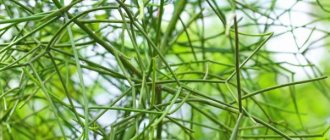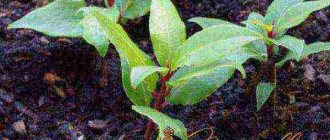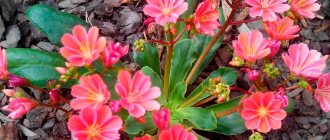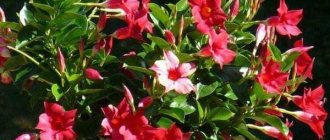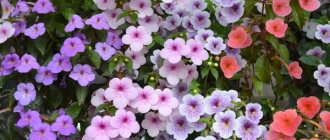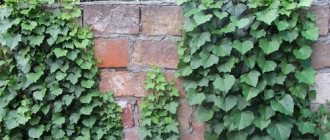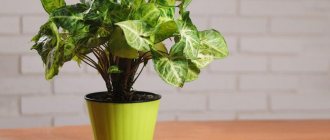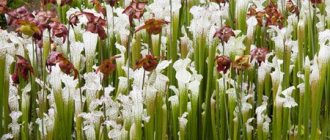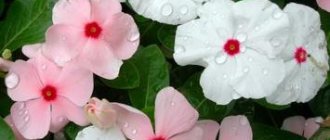Description of the appearance of the flower
Fittonia is an elegant, unpretentious indoor plant of the Acanthaceae family. It got its name thanks to the English sisters Elizabeth and Sarah Maria Fitton, who at the beginning of the 19th century published the first official textbook on botany called “Conversations on Botany”.
The genus of this plant includes 10 species, but only three of them are mainly bred in home floriculture.
The Fittonia flower is a small bush with brown stems. The plant has oval-shaped leaves with a bright green color and pink or white veins - they give the flower an overall exotic appearance. The flowers are small and yellow in color. Small flowers are collected in a spikelet-shaped inflorescence.
Fittonia looks best:
- in shop windows;
- in office premises;
- in living rooms and children's rooms;
- in florariums.
Homeland of the plant
Fittonia is a South American plant native to the tropical forests of Peru. It is a perennial ornamental deciduous plant with a maximum height of up to 60 cm. Fittonia is valued for its beautiful ovoid dark or light green leaves with bright, colorful contrasting veins, which can be from 2 to 16 cm. Fittonia flowers are small, gray-yellow in color, unremarkable.
It looks good and feels great when propagated in a terrarium or “bottle garden”. Several types of Fittonia, planted in one pot, look very attractive.
Its distinctive feature is that it can coexist next to almost all other indoor plants and even in the same pot with many domesticated trees, decorating them.
The most common types for growing at home:
- Fittonia verschatteltii. It has superficial roots and creeping branching shoots up to 10 cm high with a beautiful silvery edge in young plants and greenish in older individuals. The leaves are matte, olive in color with bright pink veins. Blooms with small flowers.
- Silver veined Fittonia argyroneura. Endowed by nature with oval green leaves with silver-white veins. Based on it, the hybrid Nana, popular among flower growers, was developed, which tolerates dry air well and has small leaves up to 2.5 cm.
- Large Fittonia (Fittonia gigantea) or giant. The most whimsical and demanding species. It has purple-red, pubescent, erect shoots, due to which it can reach 60 cm in height, green, with carmine-red veins, shiny glossy leaves.
Reviews about growing Fittonia
I have been familiar with this plant for quite some time.
It grows compactly, is always in excellent condition and pleases with its variegated coloring no less than flowering plants, which as soon as they fade, lose their appearance until the next flowering. This baby feels great in very well-humidified rooms, it requires frequent spraying and watering, but you don’t need to over-water it so that the roots don’t rot, but it shouldn’t dry out either, as its beautiful leaves may dry out or fall off. Therefore, you should not keep it on southern windowsills or near heating. You can place Fittonia in dark places, for example, among ferns or other moisture-loving plants that love light and can slightly shade Fittonia with their extensive leaves. Direct sunlight burns it, but at the same time, in the dark, the shoots will become very elongated and may lose the brightness and contrast of coloring. Unfortunately, my last Fittonia died from pests. She cannot resist scale insects and ticks, so we could not save her. Always treat new plants that you buy somewhere or take from yourself, send them to quarantine. LvIcO4ka
https://irecommend.ru/content/yarkaya-malyshka-na-podokonnike-fittoniya
I read in some magazine that Fittonia is called an elegant indoor plant, and I completely agree with them, there’s no other word for it.
These leaves with pink veins look so unusual and interesting! Gabriella S
https://otzovik.com/review_3183674.html
Fittonia attracted me with its beautiful leaves - red with green veins.
But the relationship with her did not work out! It grew in the summer, everything was fine, I sprayed it every day. But with the onset of cold weather, she began to wither. There were five plants in the pot, growing in a beautiful bush. Now there is only one branch left, the plant looks completely different! I read that it can be planted in a pot with any plant, so that Fittonia creates a beautiful appearance for the composition as a whole. I will buy Fittonia again in the spring. It is said that red flowers or leaves of plants help increase the energy of households. I don't have enough energy! Well, I'll wait for spring! mardan
https://otzovik.com/review_322502.html
Home care
Fittonia is a demanding plant that needs a few minutes of attention every day. It’s impossible to go on a long vacation and leave the flower unattended. The flower pot is placed in a place with bright, diffused light. This can be an east or west window. On a southern windowsill on a summer afternoon, the leaves are shaded to prevent burns. In winter or on the north window, use lighting. When there is insufficient lighting, the stems stretch and the distance between the nodes increases, and the contrast of the pattern on the leaves also decreases.
Choose a pot for Fittonia that is not deep, but wide. The entire root system of the plant is located within ten cm below the soil surface and grows in breadth. Let the pot be ceramic in the form of a bowl, with a mandatory drainage hole in the bottom. If the diameter of your pot is smaller than the height, then at least a quarter of the pot should be occupied by drainage - expanded clay or pebbles, otherwise moisture will stagnate in it, and the flower will suffer from dampness and excessive soil moisture.
Watering mode
When purchasing Fittonia, you should keep in mind that due to its swamp origin, it loves a humid atmosphere. This is the greatest difficulty in caring for this plant.
- Fittonia has increased transpiration, that is, the ability to evaporate moisture through its mosaic leaves, so it requires constant watering.
- It must be sprayed daily with settled or melt water; the pot should be kept on a tray with damp expanded clay, moss or wet pebbles. But it is important that the pot does not stand in water.
- The soil should be constantly moist and only dry out slightly between waterings.
- To increase air humidity, place an open container of water near the Fittonia.
- If the leaves of Fittonia are drooping and have a sluggish, painful appearance, it lacks moisture. But after watering, the plant comes to life literally before our eyes, taking on a radiant appearance in a few hours.
Even a one-time drying of the roots and soil will lead to the shedding of leaves.
At the same time, you need to make sure that the soil does not become sour, otherwise the roots will begin to rot. Water for irrigation should be settled and warm.
Lighting requirements
Fittonia is not too demanding on lighting, since in nature it grows under dense forest cover, but it will grow better and faster in a bright place. In partial shade, the plant stretches out and becomes ugly, stunted, and lethargic. Western and south-eastern windows are best suited for it. But Fittonia is quite capable of adapting to northern window sills.
- Fittonia cannot tolerate bright light, especially on hot summer days. And in winter, the plant should be additionally illuminated.
- Due to the lack of need for bright light, Fittonia can be planted next to tall, branched plants.
In general, the lighting required by Fittonia can be determined experimentally by moving the pot with the plant to different places.
Soil for fittonia
For the Fittonia plant, mixtures of “Violet” and “Geranium”, “Azalea”, which are sold in stores, are quite suitable. You can also prepare the soil yourself by mixing turf soil, coniferous soil, peat and sand.
You need to ensure that the soil is loose and moist.
Temperature
Fittonia loves warmth very much and feels great at a temperature of 24-26 degrees. The temperature should not fall below 20 degrees. At lower levels, fittonia may begin to hurt. It is better to protect from drafts - sudden changes from heat to cold will lead to leaf fall.
Fittonia, unlike many other plants, does not like being taken out onto a balcony or into the open air in the summer, even in very warm times, since it is an exclusively indoor plant.
In order to avoid accidental drafts or sudden temperature changes, Fittonia can be protected by placing it permanently in an ordinary aquarium, which will create an air layer of warm air and protect it from cold air flows. Fittonia also has a negative attitude towards tobacco smoke and gas combustion products.
Fertilizer, top dressing
In the summer (from April to November), fertilizing should be applied to the soil 2 times a month, in winter - once a month, or not fertilizing at all.
It is allowed to use complex fertilizers for all indoor plants, but in low concentration, or use fertilizers for decorative deciduous plants. It should be remembered that excess fertilizer is very harmful for Fittonia.
Transfer
It is recommended to replant Fittonia annually in early spring (March-April), since it is a fast-growing species.
Due to the shallow root system, it is better to choose a pot that is not wide and flat with a height of 5-7 cm. It is mandatory to have a hole to drain excess water and a good drainage layer. Expanded clay or finely broken brick can be used as drainage. The soil should be loose. You can use universal soil sold in stores, such as “Geranium”, “Azalea”, “Violet”, but it is better to make the substrate for your pet yourself.
Soil composition for fittonia - first option:
- 1 part deciduous soil;
- 1 part of coniferous land;
- 1 part peat substrate;
- 1 part sand.
Soil composition for fittonia - second option:
- 2 parts of coniferous land;
- 2 parts of turf land;
- 1 part sand;
- 1 part peat.
The shoots of Fittonia are very fragile; replanting must be very careful, only by transshipment, so as not to damage the roots of the plant.
Fittonia care
Born in special climatic conditions, the exotic guest is suitable for breeding only in a home atmosphere: the flower will die in open ground . However, at home she also needs certain indicators of temperature, light, and humidity.
Temperature
The heat-loving exotic feels good at a constant temperature in the region of 23 ...25 ° C. A decrease in these indicators to 18 ° C can kill a pet; it does not tolerate sudden changes in temperature .
View this post on Instagram
Posted by Natalia S (@masteritayaorchids) Feb 18, 2021 at 8:57 am PST
Lighting
In nature, the plant hides under the canopy of trees, content with scattered rays. In winter, when the sun rarely appears on the horizon and daylight hours become shorter, the flower requires an additional source of light . Use a phytolamp for illumination.
Attention! When there is excess light, Fittonia shoots begin to spread; when there is not enough light, they stretch upward. Try to find a place with a lighting mode that is comfortable for her.
Humidity
A special parameter that affects the full existence of a tropical plant in the house: it requires 90–95% humidity , which is difficult to provide at home.
Frequent spraying and placing the pot in a tray with always damp moss helps. absolutely not keep Fittonia near heating appliances , but the proximity of orchids is useful for it.
Watering
If the pet is kept in a pot, then regular watering is carried out from March to October . Then it is reduced, but gradually, making sure that the soil does not dry out. When kept in an aquarium, there is no question of watering.
Rest period
Part of autumn and winter is rest time for Fittonia. There are no significant changes in her care. Watering is reduced slightly, but the soil should remain moist.
The temperature regime does not change, remaining within 23...25 °C. To ensure that the plant receives enough light in winter, a phytolamp is installed.
Fittonia propagation
According to statistics, for a novice amateur gardener, Fittonia lives in beautiful decorative form for no more than six months, then problems begin. The plant loses its decorative effect and often dies. Experienced flower growers who have managed to create ideal growing conditions for the tropical sissy will be able to admire the wonderful leaves of their beauty, Fittonia, for several years. After these years, the old plant is replaced by its younger generation, using one of the propagation methods described below.
There are different types of reproduction of Fittonia.
Cuttings
The apical cuttings of a plant with 3-5 leaves take root quite easily in water or directly in a moist substrate (sand or light soil). But in order for the cutting to take root faster, it should not be longer than 8 cm. The substrate must be kept moist and the cuttings must be sprayed. It is better to cover them with glass or film, that is, to create a greenhouse effect. It must be warm - 25-28 degrees. Final rooting of the cuttings occurs within a month.
- It is necessary to cut off the top stalk, which should have 3-5 leaves, with a sharp tool.
- With the cut down, you need to plant the cuttings in a damp, loose substrate, or in water for several days, and then in the ground.
- To make it easier for a young plant to take root, the cut shoot should not exceed 8 centimeters in length.
Caring for the cuttings - regularly watering the substrate and spraying the plant. It is advisable to cover the young Fittonia with a transparent film or glass. A temperature of 26-28 degrees is required. Within 20-30 days the cuttings will take root completely.
Dividing the bush
This method is also quite simple - when transplanting, the bush is divided into parts, trying not to damage the roots, and then planted in separate containers.
Reproduction in this way involves dividing an adult fittonia into several parts so that each of them has its own roots. When dividing, do not damage the roots; it is better to plant them together with the soil in separate pots.
By layering
Parts of the Fittonia stem are also capable of producing roots after some time if they are sprinkled with moist soil, after which the cuttings can be separated and replanted in their own pot. Sometimes, in fairly wide pots, creeping shoots take root on their own.
- The long stems of the flower can be sprinkled with a damp substrate; after a few weeks they will sprout roots at the point of contact with the ground.
- After the stems take root, they must be carefully separated and planted in different pots.
- If the flower is grown in a wide container, then the creeping shoots can take root on their own.
You can also plant several cuttings in one pot for greater decorativeness, then the Fittonia bush will be very lush and attractive.
Fittonia flowering
The flowering period of Fittonia is moderately long - from mid-summer to mid-autumn. The flowers are small, gray-yellow in color, collected in a spike-shaped inflorescence, each of them is located in a bract.
Flowers are not the value of this plant.
Fittonia blooms in natural conditions in the spring, and grown at home, on a windowsill, in the summer. Peduncles appear directly from the leaves and have a greenish tint. Flowering Fittonia is not valuable because its flowers are small and inconspicuous. They have a yellowish color, are collected in inflorescences in the form of ears and are odorless.
Flower growers who have experience growing the presented indoor plant simply pick off the flowers to improve the quality of the leaves.
Nuances of planting and transplanting
Fittonia must be replanted annually in early spring. The store-bought plant is left alone for a week. After this period, the Fittonia is transplanted. To ensure comfort for the plant, it is important to choose the right pot and prepare the soil.
Many gardeners recommend planting several bushes of multi-colored fittonias in one pot. This will help create a unique design composition.
Choosing a pot
Fittonia's roots are located close to the surface, so this plant does not require a deep pot. At the same time, it must be wide enough. The ideal option is a pot about 8 cm high and about 18 cm wide.
Wide and low pots are best suited for Fittonia.
Important! The pot must have drainage holes through which excess moisture will be removed.
Soil preparation
Fittonia is suitable for light and fairly loose soil. If you decide to buy it in a store, it is best to opt for soils intended for growing violets and geraniums. When preparing the soil yourself, you should mix coniferous or turf soil with peat, as well as sand in proportions of 2:1:1.
Before planting Fittonia, drainage should be placed at the bottom of the pot. For this purpose, you can use expanded clay, pebbles and crushed bricks.
Important! Drainage and soil mixture for fittonia must be pre-disinfected. To do this, they are poured with boiling water or heated in the oven.
Transplant instructions
Before replanting, it is necessary to shorten the long shoots of Fittonia. After this, perform the following sequence of actions:
- The selected drainage is poured onto the bottom of the pot, and 1–2 cm of soil is covered on top.
- The plant is carefully removed from the old pot, being careful not to damage the roots.
- Excess soil is carefully shaken off.
- The root system is inspected for the presence of rot. If they find it, carefully cut off the damaged roots with a sharp knife. The cut areas are sprinkled with crushed coal.
- Fittonia is placed in a new pot, with fresh soil added to the sides and top.
- The flower is watered abundantly, and excess water is poured out of the pan.
Video: features of plant transplantation
Trimming
In order for Fittonia to branch well, it is recommended to periodically pinch out young shoots. Although the plant is perennial, over time the lower part of the shoots becomes bare, which spoils its appearance, so it needs to be rejuvenated. To do this, cut off the tops of the stems; they can be rooted in the same pot or transplanted separately.
Old shoots also need to be pruned.
Over time, the shoots may become too long and become bare at the bottom. To prevent this, you need to regularly pinch the ends and cut the flower. In the spring, pruning is carried out. The stems are shortened by half. Too radical a haircut can slow down growth and reduce decorativeness, so it is better to do it little by little in several stages.
Diseases and pests of Fittonia
Diseases and pests, as a rule, avoid Fittonia. Rarely it can be affected by:
- Thrips are small, mobile insects that suck sap from plants; they most often appear on young plants. Their presence can be determined by the appearance of small yellow spots on the leaves, which subsequently increase in size. The plant must be treated with Actellik.
- Mealybugs are located on the bases of leaves; with severe infestation, they appear on the leaves themselves. Their distinctive feature is a waxy discharge that looks like lumps of cotton wool. Get rid of it with soapy water and spraying with Actellik solution.
- Red spider mite. When infected by this pest, in addition to spots on the leaves, a cobweb forms underneath them. Plants become sick with mites due to dry air. Actellik treatment is also suitable as a treatment.
Typical care mistakes
In the process of growing Fittonia, flower growers often encounter a number of problems, the elimination of which is extremely important for the proper cultivation of the plant.
Table: eliminating common care errors
| Description of the problem | Most Likely Cause | Solution |
| Yellow and dry tips of leaves | Dry air | Frequent spraying, a container of water near the pot, a humidifier |
| Leaves lose tone and droop | Watering too infrequently | Increasing watering frequency |
| The leaves become pale, then turn yellow | Incorrect soil composition, deficiency or excess of certain minerals | Replant in optimal soil, feed in a timely manner |
| The leaves become small, the stems stretch | Lack of lighting | Move the pot to a brighter place |
| The shoots begin to rot at the base | Excess moisture or low air temperature | Adjust conditions according to optimal parameters |
Table: diseases and pests of Fittonia
| Pest | Signs | Ways to fight |
| Spider mite | Cobwebs on the plant, the leaves dry out. If there are a large number of pests, the plant dies | Grate 30 g of soap and dilute it in a liter of water. Wipe the leaves with the resulting solution, removing cobwebs. |
| If soap does not help, Fittonia should be treated with specialized products (Aktara, Fitoverm, Fufanon and others) in accordance with the instructions. | ||
| Aphid | It starts at the base of leaves and feeds on their juice. Aphids reproduce at a tremendous speed. The plant very quickly becomes surrounded by a large number of insects. The leaves dry out, curl and die. | Control measures should be taken as early as possible. The plant is treated with a soap solution, nicotine sulfate (1 g per liter of water). In this case, it is better to cover the soil with film. To completely get rid of aphids, the treatment must be carried out several times with a break of a week. |
| Mealybug | A fairly common disease for Fittonia. Starts due to excess moisture. At the initial stage, it can only be detected by careful examination of the plant. A sign of mealybug infestation is a white cotton-like coating. | Before there are too many insects, it is enough to remove them with a cloth soaked in alcohol. If the process of pest reproduction cannot be stopped, resort to insecticides (for example, Aktelik, Aktara, Fitoverm). Some gardeners combat the problem with citrus infusions. To prepare it, the peels and zest of 2 large fruits are poured with a liter of water, left for 2 days and sprayed on the plants. |
Note to the florist
Since Fittonia is very picky about external conditions and care, breaking some rules can lead to problems.
Why doesn't Fittonia bloom?
There is nothing wrong with the fact that Fittonia does not bloom, especially since it is not valued for its flowering. But if it is necessary for the plant to bloom, you can feed Fittonia with fertilizer for flowering plants or spray it with the “Bud” preparation. One of the reasons for the lack of flowers is a lack of potassium or phosphorus in the soil.
Hybrid forms of Fittonia do not bloom at all.
Why do Fittonia leaves wither?
- The falling of the lower leaves of the stems of Fittonia is a normal phenomenon; this is a sign of the need for rejuvenation.
- Yellow leaves indicate flooding; it is necessary to reduce the frequency of watering.
- The tips of the leaves can dry out and turn brown from either excess or lack of fertilizer. Wrinkled leaves indicate dry air or too much bright light.
Fittonia, thanks to its heat-loving and unpretentiousness, is an ideal plant for city apartments. Its bright, unusual colors lift your spirits, create comfort, and are worth all the troubles spent on it. If all maintenance conditions are met, this flower will not cause trouble, but will only bring joy.
Why do Fittonia leaves curl?
In essence, Fittonia does not cause any trouble to the gardener, but sometimes the leaves can curl. This will not lead to the death of the plant, but its decorative value is reduced. So what's the deal? The most common reason is lack of humidity. But exposure to direct sunlight and waterlogging can have the same effect. The flower is also afraid of temperature changes and drafts. Due to their influence, Fittonia leaves not only curl, but also fall off.
Growing conditions
Most often, Fittonia of the Verschaffelt species is grown indoors. To make her feel as comfortable as possible, certain conditions must be created.
Table: optimal conditions for keeping Fittonia Verschaffelta
| Parameter | Summer period | Winter period |
| Temperature | 20–24 °C | Not lower than 18 °C |
| Location | The flower should stand in a well-lit place, not far from the window. If it is not possible to avoid direct rays of the sun, you need to shade it. | It is better not to change the location of the plant. |
| Illumination | Lack of direct sunlight, avoid shaded areas, otherwise the leaves will lose their bright color. | In case of insufficient light, it is recommended to resort to artificial lighting methods. |
| Humidity | High humidity, spraying 1-2 times a day. | High humidity, spraying in case of dry air and high temperature. |
| Watering | Frequent (immediately when the top layer of soil dries), abundant. | With less frequency (depending on air humidity, at least once a week). Do not allow the soil to dry out. |
| Top dressing | Every two weeks. | Do not feed. |
Florarium and paludarium
Some gardeners grow Fittonia in transparent containers made of plastic or glass, even in ordinary glass jars.
Select a container with a tight-fitting glass lid.
- A little soil suitable for growing Fittonia is poured onto the bottom and moistened.
- Carefully plant the plant and close the jar.
- When condensation forms in the jar, remove the lid, ventilate the container for two hours and close it again.
This procedure will have to be carried out for some time, but after 10 days the release of condensation should stop - the microclimate necessary for the plant will be established in the jar. To decorate the composition, beautiful pebbles, marble chips, decorative clay figurines and other lovers of the tropical environment are placed in a jar with a flower - moss, miniature ferns, some types of orchids. It turns out to be a very unusual, but effective decoration for the interior of the room.
But this method of growing a flower has its weaknesses. In greenhouse conditions, Fittonia will grow very quickly, and pinching and pruning the plant, and even more so replanting it, through the narrow neck of the jar is quite problematic.
Then lovers of this tropical sissy purchase an aquarium for growing Fittonia, a special semi-closed transparent one, made of glass or plastic, reminiscent of an aquarium for breeding fish - a florarium. Florarium
There are many advantages to growing this way:
- Fittonia will be protected from drafts, temperature changes, and drying out of the soil. The flower should be watered no more than once or twice a month.
- Most often, these florariums have a wide neck and a rounded shape, which allows manipulation by pinching and trimming excess shoots. Fittonia in aquariums should not be allowed to grow too much; as the bush grows, it needs to be thinned out.
- There is no need to constantly monitor air humidity, since all the evaporated moisture is retained inside the closed aquarium. Just try to provide the plant with good lighting so that the flower does not stop growing.
- Florariums look good and fit into the interior of the apartment.
But growing Fittonia in it can also end disastrously if you have little experience in keeping flowers this way - you can damage it when replanting or cleaning the aquarium, or overfeed it with fertilizers, overwater when watering and cause rotting of the roots.
Paludarium
Finally, Fittonia can be grown in paludariums. This is an interesting, but the most expensive and time-consuming way to grow tropical sissy at home. The purchase of a spacious transparent planting container and special equipment to maintain optimal levels of illumination and humidity in it require large expenses.
In good light, Fittonia will not suffer if its roots are completely submerged in water. However, it is better to place a plant with a well-developed root system in a paludarium. When cleaning the aquarium, try to disturb its resident as little as possible - from any mechanical damage to the roots it can rot and die.
Paludarium has significant advantages in terms of crop production compared to other methods of growing it.
Fittonia grows well in it in a terrestrial, semi-submerged and even underwater version. The lighting and humidity it needs are maintained by technical means. All kinds of streams and fountains create ideal conditions for the existence in paludariums of all types of Fittonia, without exception.
Fittonia - signs and superstitions
According to the explanations of followers of the East Asian teachings of Feng Shui, fittonia personifies the energy of metal, which has the functions of control and management. By placing the plant in a suitable place, providing it with the necessary care and attention, a person will soon feel more decisive, because he will understand that it is he who controls his life and the events that take place.
Attention! Signs and superstitions about this plant have only a positive connotation.
Predictions are associated with the process of expanding one’s worldview, which results in a change in outlook on life and the desire to free oneself from piling up excesses. Often, the owners of Fittonia are easy-going people who know how to see the positive in everything.
Among the magical properties of the flower, its special influence on humans is highlighted, helping in the following areas:
- decide on the right aspirations;
- learn to protect yourself from daily worries and bustle;
- classify desires, choosing the most relevant ones;
- consider priorities;
- gain courage and determination to face change.
The energy of Fittonia is light, not oppressive, it will direct the owner to find his destiny, so that a person can do what he loves, bringing benefit to the world. It is often recommended to students to calm their minds and open them up to calmly receiving and easily assimilating new information.
As for the family atmosphere, it will broaden the horizons of the household, pushing them towards new hobbies and activities. It is noteworthy that superstitions say that a person who grows this plant will soon achieve success, forgetting about stereotypes.
Can I keep it at home?
This representative of the flora is kept indoors, at home or in the office. But the plant does not take root in everyone. It is considered to be a rather capricious representative of the flora, since many people want the plant to bloom just because it is watered. But if you manage to provide Fittonia with proper care, then it will fill the house with positive energy and have a beneficial effect on the household.
The plant will not only add coziness to the house, decorating it with its attractive appearance. Patterned foliage will captivate the eye, forcing you to cast aside negative thoughts and enjoy the beauty of the plant. Among other things, it will help with the following household chores:
- the flower will dispel negativity in the family atmosphere;
- suppress conflicts, smooth out irritation;
- quarrels will soon exhaust themselves;
- Friendship and family integrity will noticeably strengthen.
Attention! If you manage to grow a flower with a lush crown, it will increase the family capital.
It is placed in the bedroom for a good sleep or in the office to relieve tension and fatigue, freeing up space in the mind for mental functions.
Description of varieties - types with photos and descriptions
There are 4 species in the genus. Red Fittonia looks unusual and exotic with an intense bloody pattern on the leaves. The most popular varieties for home breeding are Verschaffelta, Skeleton and Mix.
VERSCHAFFELTA
This flower is distinguished by creeping shoots and branching stems. Fittonia Verschaffelta has large dark green leaves with veining in a variety of shades. This type of flower reaches 25 cm in height and loves high humidity and warmth. Well suited for flower arrangements.
SKELETON
A very beautiful plant with creeping shoots. It has small velvety leaves with a matte tint and red, densely applied veins. The leaves have a rich olive color and, due to the intensity of the color, create a luminous effect.
MIX
This is a collection of several varieties planted together. Flower growers select different varieties, plant them in one pot, choosing a range of colors so that the plant fits into the interior design.
The colors of the leaves vary from light green to dark green, decorated with veins of various shades. Thanks to the variety of shades, this flower looks organic on any windowsill.
Fittonia josan
Josan has green leaves, but wide pink veins almost cover the leaf blade, so they appear to be naturally pink. The dark green border, if you look at it from afar, looks black.
Fittonia skeleton
Creeping shoots of Skeleton bear matte leaves with a velvet surface. The pattern on them is made of red veins intertwined with a fancy mesh. In the sun's rays, the leaves of Fittonia shine delightfully, giving it a magical shape.
Fittonia white
Radically different from its fellow genus, the Mosaic Kings Cross species has amazingly beautiful leaves: not only are they painted white, they also have edges like a frill on a dress. Next to it you can put two more species: white fittonia and White Anna. Both have a predominantly white leaf color, only the first has wide veins and no green stripe along the edge, while the second has thinner veins and does have a stripe.
